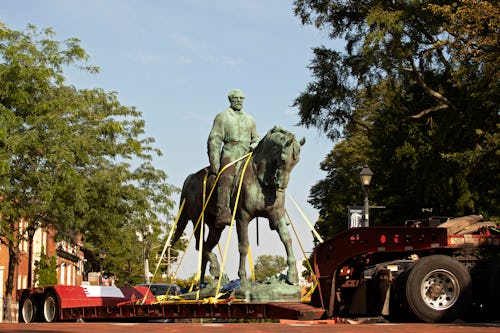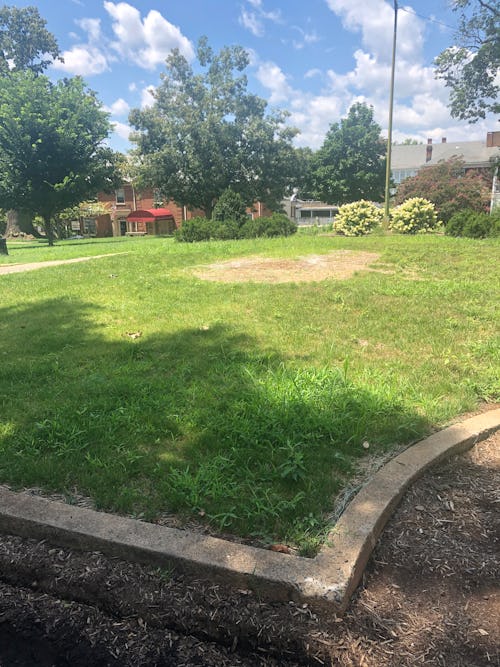
CHARLOTTESVILLE, Va.—There is nothing that makes Charlottesville’s Market Street Park stand out.
Parks always exist for a reason. Sometimes it’s innocent, like to celebrate a city’s natural beauty. While Charlottesville has no shortage of that, Market Street Park is relatively lackluster. Located in the city’s historic district, it’s not big at all, about one block. When I decide to check it out, I damn near walk past the park altogether.
I sit in the shade on one of the park’s concrete benches watching as an older man walks the small path forming a square around the park’s center. It’s empty now, aside from a slightly raised concrete barrier and a patch of dead grass. But the path makes Market Street Park’s purpose clear. You’re meant to be walking around something.
Up until last year, that something was a bronze statue of Confederate general Robert E. Lee on his horse, Traveller. Unveiled in 1924, Lee’s statue stood apart from others at the time because it didn’t come from the Daughters of the Confederacy or another similar group. Instead, Lee’s statue was commissioned by a single individual: Paul Goodloe McIntire, a businessman, and one of Charlottesville’s largest benefactors.
“All we really know about [McIntire’s] thoughts behind it [is] he said it was to honor his parents,” Sterling Howell, the programs and volunteer coordinator with the Albemarle Charlottesville Historical Society, tells me ahead of a tour of the city. While some argue that McIntire was “not a proponent of racial animosity,” he donated the land for Market Street Park to be a whites-only establishment called Lee Park. With Lee’s statue in the middle, the park served as a center of Confederate memory in Charlottesville.
The monument is now gone, the park renamed. It’s clear that Charlottesville officials want to remake Market Street Park into something, well, less celebratory of white supremacists. But the concept “out of sight, out of mind” doesn’t really extend itself to Confederate statues. In fact, the statue’s absence begs one question: Where the hell is Lee now?

In July 2021, Charlottesville removed two Confederate statues McIntire commissioned: Lee’s, and one of Thomas “Stonewall” Jackson. The removal of both monuments was hotly contested, but Lee remained the focal point, especially within Virginia. In July 2017, Ku Klux Klan members gathered at Lee’s statue to protest its removal; one month later, the Unite the Right rally organized under similar pretenses.
While McIntire’s donations entrenched white supremacy in Charlottesville, Lee’s statue had a unique role. As Andrea Douglas, executive director of the Jefferson School African American Heritage Center, tells me when I visit the center, “When these monuments are going up, it’s also about immigration. It is about the non-whitening of America.” To take a stand against this non-whitening, who better to turn to than Lee?
Following the Civil War, many white Southerners latched onto the Lost Cause, which sought to rewrite Confederate history. Part of that included downplaying slavery’s role in the war and casting Confederates as wronged American patriots. Eventually, Howell explains, “[Lee] became the symbol of the Confederacy [and] the embodiment of all those different political ideas that fed into that. He is the most symbolically rich image.”
The removal of Confederate monuments has been an ongoing issue nationwide. It gained steam after the 2015 mass shooting in Charleston, South Carolina, prompted a renewed push to confront Confederate legacy in Southern states. That year, activist Bree Newsome scaled South Carolina’s state Capitol to remove a Confederate flag. As Confederate monuments came down, though, they were often kept in storage, private ownership, or within their own localities rather than actually destroyed.
But finally, last December, the Charlottesville City Council unanimously voted to donate the statue of Lee to the Heritage Center for its Swords Into Plowshares project. The project, which takes its name from Isiah 2:4, aims to melt Lee’s statue and create new public art from the bronze. Since obtaining the statue, the center has since disassembled it.
“The basic idea of [it] is that both Dr. Jalane Schmidt and I believe that it is morally wrong to move what she calls the ‘toxic waste’ in one community to another,” Douglas says. Schmidt is a professor at the University of Virginia who, along with Douglas, led tours of Charlottesville’s Confederate monuments ahead of their removals.
Still, given Charlottesville’s firm entrenchment in Confederate memory, any decisions about the monuments have been fraught. Earlier this summer, a lawsuit brought by the Trevilian Station Battlefield Foundation and the Ratcliffe Foundation sought to stop the center’s plans to melt Lee down. Neither organization is based in Charlottesville, but The Washington Post reported they are connected to the Monument Fund, which tried to keep the statue from coming down in the first place.
The dynamic is reminiscent of the Unite the Right rally five years ago, Douglas notes. “Here are these two outside organizations being supported by an internal space. Sound familiar? 2017.”
In their lawsuit, the organizations claim that Charlottesville is trying to erase history. This argument has been invoked before; on its website, the Monument Fund claims removing monuments is “trying to hide our own history, destroying irreplaceable historical evidence, works of art, and for what?”
But as a public historian, Howell has one reminder: “Statues come down.”
“When the American revolutionaries decided to declare their independence from Britain, one of the first things they did up in New York was rip down the statue from George III,” Howell continues. “Think about all the symbols of the Third Reich that were taken down after World War II. The build landscape changes. There’s no reason to think it should last forever.”
In many ways, the lawsuit is an example of the same anxieties that fueled the erection of Confederate monuments to begin with. As Douglas explains, “Charlottesville voted for the removal of the statues. The community supports the fact that the Heritage Center has the statue and its plan for it. It decided for itself that it wants to heal in this way. Here is this group of people, again, enforcing their will.”
“As you start to think through what all of this means for a community that demands change, there is something in the water here that says we are fine with an inequitable space where white supremacist ideology is acceptable,” she continues, “as long as it doesn’t rear its ugly head. Because anything else changes our way of life.”
The city of Charlottesville is dotted with dead zones — areas where Confederate monuments once stood. While the Monument Fund describes these spaces as “empty lawns [that] teach us nothing,” Douglas says melting the statue down is one way of “creating some use value in our contemporary time.” Most importantly, Douglas says, the center’s project is “allowing voices to speak about public space which had no voice” when these monuments were put up in the first place.







